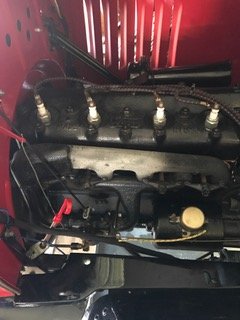Page 1 of 1
What does this mean?
Posted: Wed May 13, 2020 9:13 pm
by mgarrett

- manifold.JPG (23.23 KiB) Viewed 4471 times
Took a first drive in a car I've been working on. The car has a new engine and after a 5 mile drive I noticed steam and spitting coolant on the windshield. When I got back to the shop, I noticed the exhaust manifold center section looked ashen/grayish in color, while the rest of it was black. Perhaps running too lean? (sorry about the sideways photo - I don't know how to rotate to orient correctly)
Re: What does this mean?
Posted: Wed May 13, 2020 9:20 pm
by Norman Kling
Most likely running lean and or spark too retarded. It definately was overheating.
Re: What does this mean?
Posted: Wed May 13, 2020 9:24 pm
by Norman Kling
The picture is oriented correctly, but the manifolds look strange. Can you post another picture more close up of the manifolds.
Norm
Re: What does this mean?
Posted: Wed May 13, 2020 9:55 pm
by Steve Jelf
Blowing it up loses a lot of detail. A full size photo in a horizontal format would be better.
Re: What does this mean?
Posted: Wed May 13, 2020 10:44 pm
by mgarrett
It certainly got hot, but why would only the center 2 exhaust ports be indicating a lean mixture? I'll have to work on the mixture adjustment as well as the advance. I'm running one of the Model T Ranch distributors and set it up as well as I could understand to the instructions. I hope I didn't hurt anything. Possible I have too much advance?? Appreciate the feedback.
(Also, sommebody please help me understand how to reorient a sideways photo; I'd like to learn how!

)
Re: What does this mean?
Posted: Thu May 14, 2020 9:08 am
by Jim Sims
You have 2 exhaust ports close together, the other ports are single and far apart. Exhaust heat from 2 close together means much more heat in this area.
Re: What does this mean?
Posted: Thu May 14, 2020 11:35 am
by Altair
You could have two leaking spark plugs causing a lean condition, before you adjust the mixture assure the plugs are not leaking, they are a pipe thread and don't seal that well.
Re: What does this mean?
Posted: Thu May 14, 2020 12:01 pm
by JohnM
You say this is your first drive on a new engine? It is possible that whoever painted the manifold did not use high temperature paint, and it's just burning off. As far as the spitting antifreeze, that would happen with an over filled radiator and a missing gasket under the cap.
Re: What does this mean?
Posted: Thu May 14, 2020 2:21 pm
by Jerry VanOoteghem
JohnM wrote: ↑Thu May 14, 2020 12:01 pm
You say this is your first drive on a new engine? It is possible that whoever painted the manifold did not use high temperature paint, and it's just burning off. As far as the spitting antifreeze, that would happen with an over filled radiator and a missing gasket under the cap.
Would also happen with a new, tight engine that has only 5 miles on it. Wouldn't hurt to check mixture & timing, but before you go off on another drive, just let the engine run for 15 or 20 minutes, shut it off, let it cool, do it over again till things loosen up a bit.
I agree about the manifold discoloration as well. May just be some "finish" burning off.
Re: What does this mean?
Posted: Thu May 14, 2020 8:40 pm
by TRDxB2
Looks like some discoloration on the engine head - not sure. But paint burn off is a strong possibility - using Engine Enamel on the exhaust manifold or not following the correct curing procedure
Engine enamel paint temperature ratings POR-15 up t0 350°F Rustoleum up to 500°F VHT up to 550°F
High Temp paint temperature ratings POR-15 up to 1200° Rustoleum High Heat or Ultra High Heat 1200°F VHT Flame Proof up to 1300°F
Each paint requires a heating process for it to cure properly.
POR-15® High Temp reaches maximum hardness after heat exposure above 300°F (150°C) for 15 minutes and then allowed to cool down. The Aerosol spray can must be heat cured at a minimum temperature of 400°F for two hours.
RUSTOLEUM - Allow paint to dry for 1 hour before applying heat
VHT
On the Vehicle
Paint must be completely dry before curing
Run at idle for 10 minutes Cool for 20 minutes
Run at idle for 20 minutes Cool for 20 minute
Run under normal operating conditions for 30 minutes
Off the Vehicle
Paint must be completely dry before curing
Heat to 250°F (121°C) for 30 minutes Cool for 30 minutes
Heat to 400°F (204°C) for 30 minutes Cool for 30 minutes
Heat to 650°F (343°C ) for 30 minutes